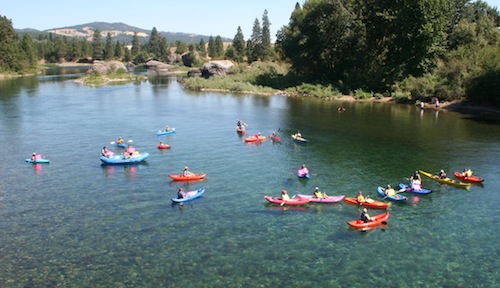Coyote Rock compromise may be possible

“In an attempt to limit human impact along the Spokane River corridor, Neighborhood Inc. is promoting the development of a controlled trail head to give Spokane residents access to the Centennial Trail and adjacent park lands owned by the City of Spokane Valley.” So writes Larry Dawes on behalf of Coyote Rock developer Neighborhood Inc. on May 1, 2009.
The Spokane River Forum agrees. This spring the Spokane Conservation District, working with the Forum and Riverside State Parks, received a ten thousand dollar grant to design a non-motorized access point at Islands Trailhead, directly across from the Coyote Rock Development. Riverside State Park owns and maintains Islands Trailhead.
According to Charlie Peterson, Field Coordinator with the Spokane Conservation District, “We’re accomplishing two really important things. The access will support an environmentally stable & safe downstream take out point for anglers and provide a put-in/take-out point for paddlers. Just as importantly, we’re going to restore 400 feet of riparian and upland habitat around the access point currently used as informal river access.”
Restoration activities will cost about $21,000 over a five year period, and is being funded through Washington Department of Fish and Wildlife.
AHBL Landscape Architects and Structural Engineers developed the access design, which has now been reviewed by over 25 stakeholders over the summer. Said Craig Andersen with AHBL, “With the Forum’s help the plan has been reviewed by agency, recreational community and conservation group stakeholders – the who’s who of river access in Spokane. The response has been overwhelmingly positive, and the suggestions first rate. One of the things we’re proudest of is that this is a low impact design, making as small a foot print on the environment as possible.” To receive a copy of the design, contact the Forum at info@spokaneriver.net.
The preliminary estimate for building the access point is seventy to eighty thousand dollars plus permitting costs. Chris Guidotti, Chief Ranger for Riverside State Parks, is cautiously optimistic. “Bringing this design to fruition means going through a multiagency, vigorous permitting process and approval from our headquarters. We’re hopeful but there are no slam dunks, particularly when it comes to shoreline projects.”
According to Andy Dunau, Executive Director of the Forum, “There are a couple different ways to go about funding the access project that look very promising. At the end of the day, however, we really hope Neighborhood Inc. gets involved. In a perfect world, the dock issue and access issues are best worked out at the same time.”
By “docks,” Dunau is referring to Neighborhood Inc.’s desire to build up to 30 docks that can accommodate power boats as part of their proposed development. As reported in the Spokesman, a No Docks at the Rock River Rally brought voice to diverse opposition to this plan. Opposition includes needs to protect red band trout, aesthetics, shoreline preservation and maintaining an idyllic setting.
Bart Mihailovich, with Spokane Riverkeeper, puts it this way, “Motorized traffic doesn’t fit the character of this area, either from an environmental or community stand point. But we do want to support community and homeowner access to the river. There are ways to do that without putting in 30 docks.”
Mihailovich’s vision also includes Neighborhood Inc. working with a coalition to ban motorized boating above Argonne Bridge. Said Mihailovich, “It’s the peacefulness of the area and ability to access water, bike and hiking trails out someone’s front door that should be marketed. The vroom, vroom crowd would be happier at one of the regional lakes.”
Later this month Riverkeeper will be meeting with Neighborhood Inc. and the City of Spokane Valley to see if a settlement can be reached.
